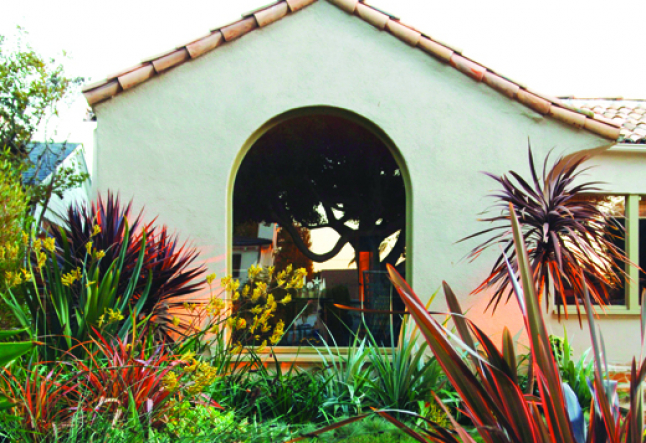creating a sustainable outdoor haven

garden of delights
California, with its temperate climate and ample year-round sunshine, is the ideal setting for gardens and other creative landscaping. Trouble is, we have been experiencing a pretty severe drought for a while now, so the idea of a water-hungry green space is a no-go. So how can we create a beautiful, welcoming outdoor space that doesn’t suck down more than its fair share of resources?
Happily for us, there are people like Ania Lejman we can ask for advice. The Venice-based landscape architect and environmentalist creates beautiful yet eco-conscious green spaces for homes and commercial buildings and is happy to share some of her landscaping tips with Yogi Times’ readers. Understanding the importance of water conservation in our fair but parched west coast cities, Ania favors using sustainable and native plants that can stand up to California’s infamously long stretches of sunny days and rainless nights. Whether you have a Gehry-designed beach house or a tiny, dark apartment, there is always a way to implement and maintain a sustainable landscape without sacrificing beauty.
The first step to creating your eco-friendly outdoor haven is to assess your space and imagine what’s possible””consider it a blank slate. “Gather every idea possible for focal features, necessary functions, and basic layout of the landscape,” says Ania. Perhaps you want a private space, a cutting garden, a place to grow vegetables and herbs, an outdoor dining area, a discovery garden for your children. “Begin collecting images that speak to you,” she says, “no matter how unrealistic they may seem to your particular space””the point at this stage is to get the creative ideas flowing. Refining the design comes later.”
If you have a lot of land to work with, Ania recommends assessing the entire property as a whole and then consider how to create interesting spaces within, such as orchards, native grass meadows or permeable walking paths. While lawns have their place, most use more than their fair share of water and front lawns in particular are underused and result in millions of gallons of wasted water each year. “This doesn’t make a lot of sense,” says Ania. “There are hundreds of ways to create low maintenance and drought tolerant gardens, and I think people are finally catching on.”
Instead of water-guzzling grass, try front garden meadows, “no mow” grasses, groundcovers such as wooly thyme, drought tolerant flowering shrubs (which will attract birds and butterflies), gardens brimming with fragrant garden sage and citrus trees, or French knot gardens (using water-wise plants such as herbs and rosemary) with gravel footpaths. The replacement of lawn with any variety of groundcover or other permeable material can reduce water use by more than 50%, Ania explains. Forget the idea that drought tolerant gardens are ”dry” or “weedy” looking. Consider other types of Mediterranean plants (which sometimes behave like native plants) that hold their rich green and olive foliage all year””with very little supplemental water. Also, try to replace conventional sprinklers with drip irrigation or “Xeri-Spray” (which reduces water volume) to eliminate water run-off. “There are endless possibilities to match your personal style and preference with whatever you have to work with,” says Ania.
Those with smaller spaces, such as a small patio or balcony, should be aware of the particular features of the area. “Your balcony situation is basically a micro-climate, so be sensitive to your particular space,” says Ania. Consider how much sunlight, shade and wind the space endures and plant accordingly. “Keep in mind that not all plants like growing in containers,” says Ania. “In fact most plants resent having their roots crowded.” Container plants that thrive in sunny locales include olive trees, cordylines, flax, rosemary, Mexican feather grasses, true geraniums, aloes and succulents, while hardy ferns, sanseverias, and scheffleras will flourish in a shadier environment. “And remember, all container plantings must have good drainage in order to thrive,” Ania advises.
Regardless of the size of the space, indigenous plants are the natural””and therefore easiest””choice. They’ll appreciate the bright sun, low moisture and calcareous (sandy) soil of this region, ensuring a healthy plant requiring minimal upkeep. “It’s important to really assess your particular situation first””shady, sunny, partial sun, clay soil, sandy soil, or somewhere in between””and go from there. The trick is to tune in to your environment and plant something appropriate,” suggests Ania. “There are plants for every imaginable type of condition, even dry shade. There are hundreds of hybrid plants from parent native plants that will perform well in average garden soil without much supplemental water. Look into California native hybrids such as Salvia ”˜Allen Chickering,’ an ornamental sage and one of my all time favorites.”
If you’re looking for inspiration, check out Pasadena’s Descanso Gardens or Theodore Payne in Sun Valley for excellent examples of California native gardens. Gather inspiration bit by bit, grab a spade or a shovel and create the backyard paradise of your dreams using what nature intended.
Ania Lejman is Principle Designer of ALD Landscape Planning and Design, based in Venice, CA. aldco.com